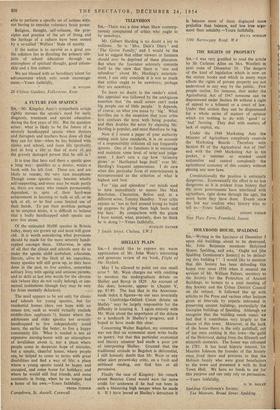A FUTURE FOR SPASTICS
SIR,—Mr. Kingsley Amis's sympathetic article rightly stresses the spastic's need for early diagnosis, treatment and special education during the first years of life. But the question arises: what is likely to be the future of a severely handicapped spastic when doctors and therapists and teachers have done all that they can for him—when he has finished with clinics and school, and faces life (probably just as long a life as that of most of us) the gravely damaged person that he still is ?
It is true that here and there a spastic goes a long way: qualifies as a doctor, writes a book with his left foot. These are, and are likely to remain, the very rare exceptions. Though some spastics may become wholly self-supporting; and•more may be made partly so, there arc many who remain permanently dependent, in spite of their hard-won achievement in learning, to walk at all, or to talk at all, or to find some limited use of their hands. To put their problem perhaps in its simplest terms, it is difficult to believe that a badly handicapped adult spastic can ever live alone.
Of the estimated 30,000 spastics in Britain today, many are grown up and most will grow old. It is worth considering what provisions should be made for the more severely handi- capped amongst them. Otherwise, in spite of all that the clinics and schools may do to make the spastic child ambulant, articulate, literate, alive to the limit of his capacities, many spastics will still grow up, as they have done in the past, to live aimless, somewhat solitary lives with ageing and anxious parents, and to drift at last into wards for the chronic sick (where they do not really belong), or into mental institutions (though they may be very far from mentally defective).
The meld appears to be not only for clinics and schools for young spastics, but for residential homes (dare one hope with no means test, such as would virtually exclude middle-class applicants ?), homes where the adolescent and older spastics too severely handicapped to live independently could learn, the earlier the better, to live a happy community life. What is needed is not an expensive nursing-home with an atmosphere of invalidism about it, nor a place where people come in desperate hope of miracles, but a simple, cheerful house, where people caq be helped to come to terms with great disabilities and find a way of life; a place where a young spastic could be happy and occupied, and come home for holidays; and where he would still find friends, and some continuity in living, when he no longer had a home of his own.—Yours faithfully,


























 Previous page
Previous page